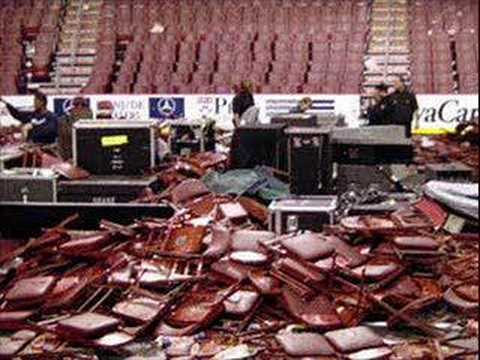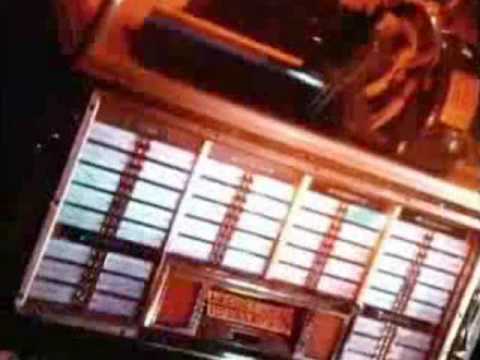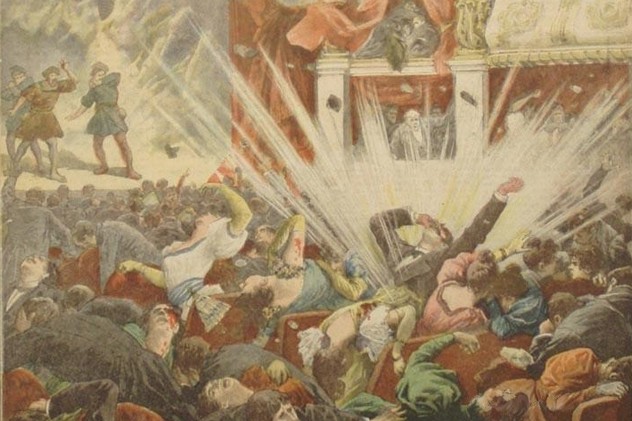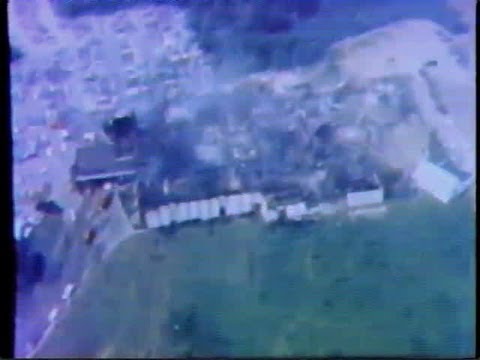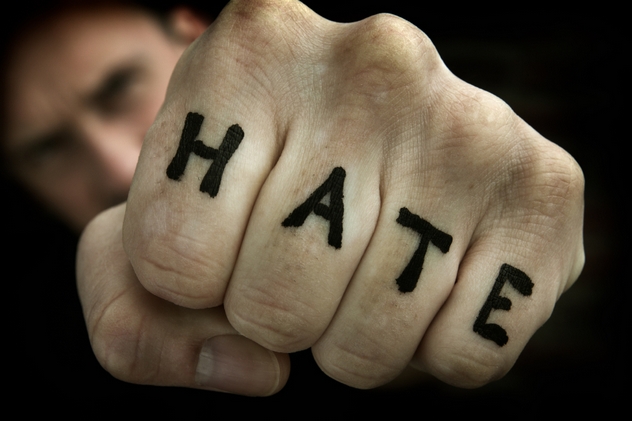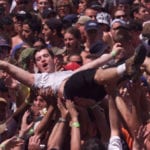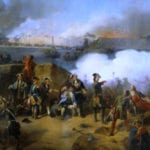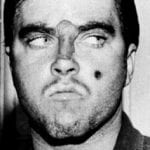Then the worst thing imaginable happened at the Bataclan theater in Paris, where several terrorists armed with Kalashnikovs opened fire at a crowd watching a rock show featuring the American band Eagles of Death Metal. When the smoke cleared, 89 people were dead after hours of gunfire, hostage taking, and at least one suicide bombing. Incredibly, this isn’t the first time such violence has struck a concert, nor will it be the last. Violence, death, and destruction have plagued live music for centuries and will probably remain a distant specter shadowing music for the foreseeable future.
10Tushino Bombings
By 2003, the Second Chechen War was three years old. The war, which included a massive military campaign from Vladimir Putin’s Russia, was not just confined to the small Caucasian republic. Chechen mujahideen, many of whom had ties to not only homegrown terrorist networks like the Caucasus Emirate but also to Al-Qaeda, began carrying out indiscriminate attacks against Russian civilians outside of Chechnya. On October 23, 2002, some 50 Chechen terrorists stormed a performance of the musical Nord Ost at the Palace of Culture in Moscow. The ensuing standoff lasted 57 hours and was only ended after Russian special forces pumped a powerful narcotic gas into the theater. All in all, a majority of the terrorists were killed along with 120 hostages. Less than a year later, on July 5, 2003, two female suicide bombers detonated themselves at a rock concert at the Tushino airfield near Moscow. Called Krylya (“Wings”), the concert reportedly included some 20,000 people in attendance. When the two suicide bombers approached separate entrances at the open-air concert, they triggered their explosive belts. Even though one bomb belt was only partially detonated, the bombers managed to kill 14 concertgoers. It was later revealed that one of the suicide bombers had a Chechen name, thus underscoring the very real threat Russia faced from the restive republic. Within a few months, two more female suicide bombers struck in North Ossetia and killed 50. Then, in December 2003, Chechen terrorists attacked a commuter train in Stavropol, killing 36. Today, even though Russia has virtually pacified Chechnya and has a pro-Moscow strongman in power in Grozny, the threat of Islamist terrorism inside of Russia remains very real, especially considering the sheer amount of Chechens who have traveled abroad in order to fight for ISIS.
9Colectiv Nightclub Fire
In front of a packed house on October 30, 2015, Romanian rock band Goodbye to Gravity was performing inside of the Colectiv nightclub in Bucharest. At some point, a fire erupted on the stage that caused panicked attendees to rush for the exit doors. As it was initially reported, the fire, the smoke, and the melee ultimately contributed to the deaths of 27 people and the hospitalization of 180 more. In response to the tragedy, the Romanian government called for three days of mourning. Within days, the death toll climbed to 45 (some outlets have reported the number as being as high as 60), with Bogdan Lavinius, the drummer for Goodbye to Gravity, being among the dead. Also, as investigators began looking further into the fire, they discovered many disturbing facts. First of all, Colectiv, which was housed on the ground floor of a former shoe factory, contained only one exit. Second, many emergency service officials admitted that they had no idea that the club was even in operation until the tragedy occurred. In the wake of these revelations, some members of the Romanian government have publicly called for the resignation of certain emergency service personnel.
8Randy Blythe Manslaughter Case
In 2010, American heavy metal band Lamb of God was touring Europe. For the most part, the shows were loud, brash, and, outside of the mosh pit, entirely peaceful. Then, when the band arrived in the Czech Republic, all the good energy turned negative. While the band was performing at the Abaton club in Prague, a 19-year-old concertgoer named Daniel Nosek got up onstage in order to perform the “stage dive” leap, which is incredibly common at heavy metal shows. When the concert footage was reviewed by the Czech police, it looked as if Nosek had been violently pushed by a security guard and Randy Blythe, the lead singer for Lamb of God. Normally, such footage would not be considered scandalous, but the case of Daniel Nosek turned tragic when the young man died after complications stemming from the concert. Specifically, after Nosek rocketed off the stage, he landed on his head, thus causing massive brain damage that led first to a coma, then death. Two years after the incident, Blythe was arrested in the Czech Republic and charged with manslaughter. For 37 days, Blythe was held in Prague’s Pankrac Prison until bail could be posted. In 2013, against the wishes of several legal experts, Blythe returned to the Czech Republic in order to stand trial. He was ultimately cleared of all charges during both the trial and at a later appeals court. Following the entire ordeal, which inspired a small cottage industry of “Free Randy Blythe” merchandise, Blythe and members of Lamb of God have attempted to sue for damages, but a Czech court recently threw the case out.
7Beer Bottle Ends A Show And Causes A Riot, 1980
If you’ve ever been to a loud rock concert, then you know that UFOs are far from rare. But instead of little green or gray men coming to Earth in search of intelligent life, unidentified flying objects at rock concerts tend to be things like beer bottles, water bottles, panties, bras, or other items that are hurled at the stage at varying rates of speed. Most of the time, bands just shrug off these incoming projectiles and never mention them. Occasionally, some of these items not only make it to the stage but even manage to hit one of the musicians. As can be guessed, most musicians do not like being pelted, and some have even made it a policy to end their shows after being hit with something from the crowd. On October 9, 1980, Geezer Butler, the bassist for Black Sabbath, left a gig in Milwaukee after being struck with a beer bottle while the lights were down. Butler was eventually hospitalized because of the incident, but in the meantime, the band canceled the show. This led to a large riot that was captured for posterity by an audio recording, which you can hear in the video above. Despite the crowd’s ferocious rage, the riot only caused structural damage—over $10,000 in damage, to be exact—before police managed to dispel the unruly crowd.
6Bill Haley Causes Riots In West Germany
Long before heavy metal and punk rock, simple, plain old rock and roll was considered a major threat to society. Certain radio DJs delighted in banning the music from their stations, while television personalities did much to try and limit the genre’s popularity among teenagers. All efforts failed, of course. Before rock and roll’s first decade was done, it was already the voice of a generation. Teenagers all across the world flocked to this new, high-speed rhythm with gusto. Most just wanted to dance, but a few wanted something a little extra. In 1958, during an October show at the Ernst-Merck-Halle in Hamburg, West Germany, Bill Haley & His Comets—who are best remembered today for the above song “Rock Around the Clock”—were busy performing when certain youths in attendance began picking fights with the Hamburg student association. Next, when about 100 police officers arrived, members of the crowd continued to throw punches and objects until the concert was terminated early. The Hamburg show cost some 20,000 deutsche marks in damage. Later that month, when Bill Haley and his band played at the Sportpalast in Berlin, another riot erupted that caused 50,000 deutsche marks in damage. The Berlin concert also proved to be more costly in terms of human health, for five police officers were badly beaten and six members of the audience were hospitalized. Despite Haley’s clean-cut image, the riots became a hot news item of the day. In West Germany, the riots were condemned as examples of out-of-control juvenile delinquency, while propaganda ministers in East Germany and in the Soviet Union called Haley a “rock and roll gangster” with an anti-socialist agenda.
5Fire And Egos Cause A Riot In Montreal, 1992
Thanks to the popularity of bands like Nirvana and Metallica, hard rock was enjoying a renaissance in the early 1990s. So, when Guns N’ Roses and Metallica went on tour together along with equally popular acts like Faith No More, Motorhead, and Ice-T’s Body Count, they performed in front of sold-out stadiums all across the US and Canada. However, the tour took a sharp left turn on the night of August 8, 1992, when a series of unfortunate events helped to inspire a large riot that turned Montreal into a minor war zone. The problems began during Metallica’s set. During a performance of the band’s single “Fade to Black,” guitarist and lead singer James Hetfield accidentally walked into a pyrotechnic fire. This freak accident left Hatfield with second- and third-degree burns and caused the band to end their set early. Guns N’ Roses could have salvaged the situation, but lead singer Axl Rose decided to (metaphorically) throw gas on the fire instead. By 1992, Rose was already infamous for his explosive temper and his knack for causing riots. So, at the worst possible time, Rose claimed that his voice was sore and cut his band’s set early in front of 53,000 impatient fans. Incensed, more than 2,000 concertgoers took to the streets of Montreal and began breaking store windows and burning cars. Overall, about eight police officers and 10 concertgoers sustained minor injuries, while over a dozen arrests were made in order to disperse the crowd.
4Liceu Opera House Bombing
Terrorism is nothing new. Even the modern style of terrorism that we today associate with groups like ISIS or Al-Qaeda has been done before. During the 1890s, a wave of anarchism and left-wing terrorism rolled through Europe. Primarily active in France, radical terrorists managed to hit soft targets farther afield as well. On November 8, 1893, during a performance of Gioachino Rossini’s William Tell, a bomb went off in Barcelona’s Liceu Opera House. The attack, which was part of a larger string of anarchist- and socialist-inspired violence in Spain, killed at least 30 and left many more maimed and injured. At that point, the bombing of the Liceu Opera House was one of the worst terrorist incidents in the history of Europe and had managed to kill more people than all the terrorist incidents of the 1880s combined. As the facts came out, it was revealed that anarchist Santiago Salvador had dropped his bomb from the fifth floor onto the lower stalls. Following this incident and a later bombing of a Corpus Christi procession that killed 12 people, the Spanish police violently cracked down on anarchist communes and parties affiliated with the anarchist movement. Ultimately, six men were accused of participating in the bombing. In May 1894, they were lined up in front of a firing squad in Barcelona. Following their executions, a series of revenge attacks, assassinations, and massive arrests rocked Spain and France.
3Mawazine Stampede
Large music festivals are always one bad accident away from a major riot. Because of the sheer size of these concerts, security and safety must be maintained at all times in order to stop minor incidents from becoming big, tragic ones. During the 2009 Mawazine Festival in the Moroccan capital of Rabat, approximately 70,000 concertgoers were packed inside the Hay Nahda stadium to see a free performance by the Moroccan pop singer Abdelaziz Stati. As the set came to a close, the large crowd began to rush out of the stadium in order to leave the area. In the rush, the crowd toppled a wire fence, which in turn caused panic to set in. The ensuing stampede killed five women, four men, and two children. Tragically, this deadly stampede occurred on the last night of the nine-day festival, which might explain why the crowd was in such a frenzy to leave the stadium. Whatever the case, the Mawazine Festival is still held annually, even despite the objections of Morocco’s many hard-line Islamists.
2Beverly Hills Supper Club Fire
On May 28, 1977, the Beverly Hills Supper Club of Southgate, Kentucky, was the scene of a horrific fire that killed approximately 165 people and injured more than 200. Originating in the club’s Zebra Room and spreading all the way to the Cabaret Room, the fire occurred while the nightclub was over capacity due to Memorial Day celebrations. In the Cabaret Room, popular entertainer John Davidson was performing, which also contributed to the nightclub’s large crowd that night. According to the investigation, the Beverly Hills Supper Club could safely house about 600 people given the amount of exits the nightclub contained. On the night of the fire, the crowd in attendance was somewhere near 2,400–2,800 people. Investigators later determined that the fire was electrical in nature and began well before it was noticed by staff or those attending John Davidson’s performance. Once smoke finally reached the Cabaret Room, the crowd panicked and rushed for the exits. Many unfortunate attendees fell down and were trampled. Others were smashed against the exit doors, thus causing a serious blockage of certain exits. It was also revealed that some exits had been locked by management. After the fire, there was a renewed focus on certain types of construction materials (the Beverly Hills Supper Club was not as fireproof as advertised), fire codes, and building codes. While some continue to believe that the incident may have been the result of arson, the true legacy of the fire concerns how subsequent lawsuits helped to redefine what was acceptable in terms of “class action” legal arguments.
1San Bernardino Punk Riot
To those not in the know, your average punk rock or hardcore show has the appearance of a riot, but the truth is that most mosh pits are controlled acts of violence, with unspoken rules dictating proper behavior. That said, real violence is not a rarity at punk shows. During the 1980s, when hardcore punk was being born, shows routinely turned violent as fans pounced on fans or, occasionally, tried to pick fights with the band members themselves. In 2006, during a festival entitled “British Invasion 2k6,” a riot broke out in San Bernardino, California, after neo-Nazis and other white supremacists charged the show, sparking a clash with concertgoers. At some point during the melee, one of the neo-Nazis was stabbed, while the others were attacked with stubbed belts, beer bottles, and other items. While security tried to drag the wounded men away, Total Chaos and The Varukers—two British punk bands—continued on with their sets. Sadly, when San Bernardino police arrived in order to remove the wounded neo-Nazis from the venue, the crowd became even more agitated and began fighting each other and some of the responding officers. Eventually, San Bernardino police were joined by members of the Los Angeles County Sheriff’s Department and Fontana police. In order to finally clear the crowd, pepper spray and tear gas were deployed, which caused the angry punks to bring their riot outside. On the streets of San Bernardino, the punks destroyed two police cars, lit a trash can on fire, and broke several nearby store windows. Benjamin Welton is a writer based in Boston. His work has appeared in The Atlantic, The Weekly Standard, Listverse, Metal Injection, and others. He currently blogs at literarytrebuchet.blogspot.com. Read More: Twitter Facebook The Trebuchet



